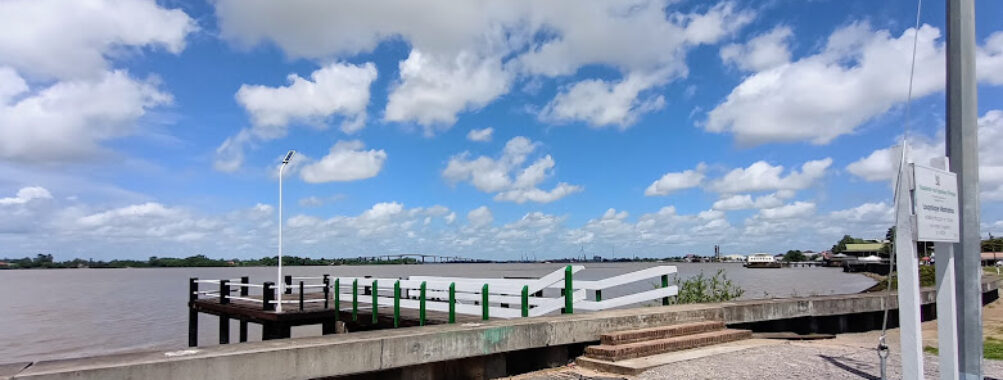
Marinetrap
“`html
Table of Contents
Description
The Marinetrap in Paramaribo is one of those places that quietly holds the weight of history without shouting for attention. It’s not the kind of landmark you stumble upon by accident—it’s the kind you seek out because you’ve heard whispers about its past, its purpose, and the curious mix of stories that surround it. Some people come expecting a grand fortress; others find something smaller, more personal, and somehow more haunting. Either way, it leaves an impression.
Standing amid the tropical hush of Suriname’s landscape, the Marinetrap feels like a relic from another time. Its weathered walls and subtle architectural details hint at its role in the maritime history of the region—back when ships ruled the waterways and the coast was alive with trade, defense, and discovery. It’s a place where the past doesn’t just sit still; it lingers in the air, in the faint smell of salt and wood, in the quiet hum of the nearby river.
When I first visited, I remember thinking how strange it was that something so historically important could feel so peaceful. There’s a sense of stillness that sneaks up on you. You don’t just look at the Marinetrap—you feel it. The textures, the chipped stone, the faint echoes of footsteps from long ago. It’s humbling, really. And while it’s not a massive tourist hub, that’s part of its charm. You can take your time, wander around, and let your imagination fill in the blanks.
Some visitors call it underrated; others say it’s a hidden gem. I’d say it’s both. It’s a reminder that not every historical site needs to be polished or overrun with crowds to matter. The Marinetrap tells its story quietly, and if you’re patient enough to listen, you’ll walk away with a deeper appreciation for Suriname’s layered past.
Key Features
- Historic maritime structure with preserved architectural details from colonial times
- Authentic, minimally restored design that retains its original character
- Peaceful surroundings ideal for reflective exploration and photography
- Informative local guides occasionally available to share historical context
- Close proximity to other cultural and historical landmarks in Paramaribo
Best Time to Visit
If you’re planning a trip, the dry season—roughly from August to November—is usually the best time to visit. The weather is more predictable, and the paths around the site are easier to navigate without the heavy rains turning everything into a mud puddle. But honestly, there’s something special about visiting after a light rain too. The air smells fresh, the colors pop, and the whole place feels alive in a quiet sort of way.
Mornings are particularly magical. The light hits just right, giving the old stone a golden glow. Plus, it’s cooler, and you’re more likely to have the place to yourself. Evenings can be beautiful too, but the mosquitoes—well, let’s just say they’re not shy. Bring repellent if you plan to hang around for sunset.
How to Get There
Reaching the Marinetrap is part of the adventure. It’s tucked away from the main bustle of Paramaribo, so you’ll probably need a local driver or a guided tour to find it easily. The roads can be a bit rough in spots, but that’s half the fun—especially if you enjoy seeing the quieter, less touristy side of Suriname.
If you’re renting a car, make sure your GPS is updated and maybe double-check with locals along the way. They’re usually more than happy to point you in the right direction (and might even share a story or two about the site). Public transport isn’t the most reliable for this route, so plan ahead if you’re not driving yourself.
And here’s a little personal tip: pack some snacks and water. There aren’t many facilities nearby, and you’ll appreciate having a small picnic once you arrive. There’s something oddly satisfying about sitting near the ruins, munching on something simple, and just taking it all in.
Tips for Visiting
Visiting the Marinetrap isn’t complicated, but a few small things can make your experience much smoother—and more memorable.
- Wear comfortable shoes: The ground can be uneven, and you’ll want to explore every corner without worrying about your footing.
- Bring insect repellent: Trust me on this one. The area’s natural beauty comes with a few buzzing companions.
- Go early: The morning light is perfect for photos, and you’ll beat the heat.
- Take your time: This isn’t a site to rush through. Let yourself slow down and really absorb the atmosphere.
- Respect the site: It’s a historical landmark, not a playground. Avoid touching fragile structures or leaving any litter behind.
Something I learned the hard way—don’t expect flashy signs or guided tours on every corner. The Marinetrap is more about discovery than presentation. That’s actually what makes it special. You get to experience it almost as it’s always been—quiet, a bit mysterious, and full of stories waiting to be uncovered.
And if you’re the type who loves photography, bring your best gear. The textures, the play of light and shadow, the way nature has gently reclaimed parts of the structure—it’s a dream for anyone who enjoys capturing the beauty of imperfection.
So, if you’re heading to Paramaribo and want something that feels authentic, grounded, and deeply rooted in Suriname’s maritime history, the Marinetrap is worth your time. It’s not the flashiest landmark, but it’s one that stays with you long after you’ve left. Maybe it’s the silence, maybe it’s the sense of connection to the past—but whatever it is, it’s something real. And in a world full of polished attractions, that’s a rare thing.
“`
Location
Places to Stay Near Marinetrap
Find and Book a Tour
Explore More Travel Guides
No reviews found! Be the first to review!